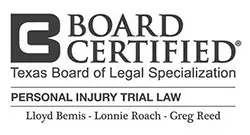Scoliosis and Qualifying for Disability Benefits
Can I get disability benefits if I am suffering from the effects of Scoliosis?
Author: Attorney Greg Reed
Updated: 11/30/2023
Approximately two to three percent of Americans are affected by Scoliosis, an abnormal sideways curvature of the spine that can develop in infancy or early childhood. Scoliosis is primarily diagnosed in adolescents and teenagers between the ages of 10 and 15, but also occurs in adults. Both boys and girls are equally affected, however, the condition progresses more rapidly in girls. Most cases of scoliosis are mild, but severe scoliosis can be disabling. If you are suffering from the effects of Scoliosis you may qualify for disability benefits.

Scoliosis is not listed as an impairment by Social Security in its Blue Book, but it is still possible to qualify for disability benefits. The criteria of a listed impairment must be matched or the inability to work due to symptoms must be proven. Call 512-454-4000 for help today.
Scoliosis is classified as idiopathic, congenital, neuromuscular or degenerative.
Eighty percent of cases are idiopathic, meaning there is no known cause. Congenital scoliosis develops before birth, resulting from malformation of one or more vertebrae at any point in the spine. Neuromuscular scoliosis is caused by a neurological or muscular disease such as cerebral palsy, spinal cord trauma, muscular dystrophy, spinal muscular atrophy or spina bifida. This type of scoliosis generally progresses rapidly and often requires surgical treatment. Degenerative scoliosis affects adults and develops in the lower back as a person ages.
Mild cases of scoliosis can develop in children without notice because symptoms appear gradually and do not cause pain, but the most common signs and symptoms of scoliosis include:
- Noticeable curve in the back
- Uneven shoulders
- One hip higher than the other
- Uneven waist
- Leaning to one side when standing
- One shoulder blade appears bigger
- Ribs stick out father on one side of the body
- Back pain and stiffness
- Pain and numbness in legs
- fatigue
These or a combination of these symptoms can cause you to miss work and jeopardize your ability to maintain employment.
When diagnosing scoliosis, a doctor will often ask a patient to bend from the waist to see if the spine is curved, but an ordinary x-ray can confirm diagnosis and the severity of the curvature.
A curve in the spine with an angle greater than 10 degrees on an x-ray is considered scoliosis. A doctor may also conduct a neurological exam to check muscle weakness, numbness and abnormal reflexes. People with a mild curve of the spine may not need any treatment aside from regular checkups to make sure their condition is not getting worse, but if a person has a moderate to severe curvature, bracing or surgery to reduce the curve may be necessary.
Demonstrating that you are following your doctor’s treatment plan is an important part of qualifying for disability benefits.
Qualifying for Disability for Scoliosis
Most people who suffer from scoliosis have mild symptoms and are easily treated, but those with severe cases may experience chronic back pain, nerve damage, and difficulty breathing if the spine presses on the rib cage.
In adults, the impact of scoliosis can be similar to other conditions such as arthritis and interfere with daily tasks and prevent working. Spinal disorders are among the most frequent claims on applications for SSDI, but only those applicants with the most severe symptoms and supporting medical evidence will qualify. Scoliosis is not listed as an impairment by Social Security in its Blue Book, but it is still possible to qualify for disability benefits.
There are two ways you can qualify for Social Security disability benefits under a diagnosis of scoliosis:
- Matching the criteria of one of Social Security’s listed impairments; or
- Proving you are unable to perform any job because of symptoms and functional limitations resulting from scoliosis.
Social Security will evaluate how scoliosis causes you pain and limits your ability to move.
For example, if scoliosis causes pressure on nerves, affecting your ability to walk or use your hands, Social Security may evaluate your claim under a Blue Book listing for musculoskeletal disorders. If your symptoms don’t interfere with daily routine, like shopping and caring for yourself, you won’t qualify.
Scoliosis is one of the more difficult disorders to receive disability benefits for; with modern medical advances, it is rare that scoliosis cannot be treated.
Make sure that your medical and treatment history shows sufficient effort to fix your spine. Be prepared to submit complete medical records which should include the following:
- Diagnosis of scoliosis
- Notes from a physical examination and doctors’ visits detailing symptoms of pain, weakness and reduced range of motion
- Medical imaging, including x-rays and MRIs
- Medical evidence of nerve compression
- Medications you are taking and any side effects
- Reports from visits to specialists such as orthopedic surgeons or neurologists
- Emergency room visits
- Physical therapy records detailing limitations in activities like lifting and bending over
- Use of a back brace or assistive device
- Surgery reports

If your scoliosis doesn’t meet the criteria of a listed impairment, you may still qualify for disability benefits if you can prove there aren’t any jobs you can do because of your condition.
Social Security will evaluate how your limitations affect your ability to work (called a medical vocational assessment), taking into account whether or not you are able to drive, your age, and level of education.
Social Security will conduct a Residual Functional Capacity assessment considering:
- How long you can sit, stand, and walk
- How much weight you can lift and carry
- Any restrictions on your ability to move
- Any mental limitations you have such as concentrating due to pain
If Social Security determines there are no jobs you can perform, you may qualify as vocationally disabled.
If you are 55 or older or have another medical condition you may get approval.
Social Security follows a set of rules to determine when the agency expects an applicant to learn a new job.
Applicants who are 55 or older often fall under a grid rule, which means they are not expected to learn a new job. For example, a 55-year-old applicant with no transferable skills might be found disabled. If you can’t go back to your old job, and you don’t have the skills to learn a new one, Social Security will likely grant you disability benefits.
You may also be eligible for Social Security Disability benefits if you have another medical condition; for example, diabetes or high blood pressure.
One disorder by itself may not match the requirements of an impairment as stated in Social Security’s Blue Book, but if you have more than one medical condition, Social Security must consider how those health issues combined limit your ability to hold a job and perform necessary daily tasks.
Social Security also has basic financial requirements.
Before you are eligible for Social Security disability benefits, you must satisfy some basic financial requirements.
You must: 1) have a disability that has lasted or is expected to last 12 months; and 2) you must have worked in a job where you paid Social Security taxes long enough and recently enough; and 3) you must not earn more than Substantial Gainful Activity (SGA), which is $1,550 per month in 2024 for nonblind applicants and $2,590 per month for blind applicants.
What if I don’t qualify for SSDI?
If you haven’t worked long enough to earn enough work credits, or if you earn too much income, you may be eligible for disability benefits through another Social Security program, such as Supplemental Security Income (SSI), or from a long-term disability insurance plan through your employer or a privately purchased policy.
SSI is a program that pays monthly benefits to people with limited income and resources who are disabled, blind, or age 65 or older. SSI is based on income instead of work credits, and is financed by general funds of the U.S. Treasury.
I have long-term disability insurance – should I file a claim?
Yes, you should file a claim as soon as you become disabled.
Long-term disability insurance (LTD) is coverage that protects your income if you are unable to work due to illness or injury and is purchased as part of a group employment plan or privately through an insurance company. Policies pay between 50-60% of your salary and benefits continue until you return to work or for the number of years stated in the policy. However, LTD coverage is good only as long as you are employed, so do not quit your job before you file a claim, and be sure to check your policy’s definition of “disabled” as each policy will state the definition of “disabled” which is in use. Additionally, be aware that long-term disability insurance companies can require a claimant to also apply for SSDI.
How do I file for Social Security Disability benefits?
You can apply for Social Security Disability benefits online, over the phone, or in person at your local Social Security Administration office.
If your initial application is denied, don’t be discouraged. Approximately 65% of initial applications are denied, but you will have the opportunity to appeal.
There are four steps to the Social Security appeal process:
- File a Request for Reconsideration with the Social Security Administration to completely review the case.
- If you don’t agree with SSA’s response to your Request for Reconsideration, you can request a hearing before an Administrative Law Judge (ALJ). ALJs are attorneys who work for the Social Security Administration; they review SSDI cases and either uphold or overturn decisions to deny SSDI benefits. If you are not represented by an attorney at this point, now is the time to obtain legal counsel. This is a critical point in the process and will raise your chance for success.
- If an ALJ does not grant your claim, you can request that the Appeals Council review your case.
- Federal Court review. The final step in the appeal process is filing suit in U.S. District Court.
If you are suffering from Scoliosis and have been denied disability don’t give up! Most are initially denied. Just call 512-454-4000 for a free, no obligation consultation to learn your options and have your questions patiently answered.
Do I need a disability attorney for SSDI?
Qualifying for Social Security Disability benefits is problematic because the requirements of Social Security’s impairment listing are very difficult to decipher.
Your chances for approval are increased significantly if you have an experienced disability attorney who can gather your necessary medical evidence and even write a brief explaining why you qualify. At each potential stage of the process, from the initial application stage, the reconsideration stage and the ALJ hearing stage, an attorney can assist you in completing the detailed forms and questionnaires required by Social Security, collecting and submitting relevant medical evidence, and preparing questionnaires for your doctors. At the ALJ hearing phase an attorney will not only continue to assure that the evidence is complete, but prepare you for questioning by the ALJ, prepare an argument on your behalf and question any doctors or vocational experts selected by the ALJ to testify at the hearing. At the Appeals Council and federal court level, a lawyer can present legal arguments to show your case was wrongfully denied. Fees charged by disability attorneys are regulated by federal law and are usually 25% of disability backpay you are owed. There are no out-of-pocket costs, and if you don’t win your case, you won’t be charged anything.
Do I need a disability attorney for a long-term disability insurance claim?
Whether you have a long-term disability insurance policy purchased through a private insurance broker or a group policy purchased with your employer, filing a claim for long-term insurance is a complex process.
The wording of LTD policies can be confusing and the laws and regulations which affect the two types of LTD insurance differ in their procedures for filing claims and appeals. An experienced LTD attorney with thorough knowledge of ERISA laws and regulations will avoid mistakes and increase your chance of success. An attorney will act on your behalf, completing your application and filing your claim in a timely manner. They can also negotiate a settlement or file an appeal for you. If it becomes necessary to file suit, an LTD attorney can prepare your case against an insurer. Most LTD attorneys handle cases on a contingency basis and charge approximately 25%-40% of a claimant’s past due benefits. You do not pay an attorney’s fee unless the attorney wins your case.
Disability benefits are an important source of income for those who are unable to work. If you are not able to work due to accident or illness, you may be eligible for Social Security Disability or Long Term Disability benefits. If you have applied for benefits and been denied, contact the attorneys at Bemis, Roach and Reed for a free consultation. Call 512-454-4000 and get help NOW.
Try these links for further reading on this subject:
When Should I apply for Social Security Disability?
It helps to have a supportive doctor when you file for disability
What Information will I need to apply for SSDI?
Author: Attorney Greg Reed has been practicing law for 29 years. He is Superlawyers rated by Thomson Reuters and is Top AV Preeminent® and Client Champion Gold rated by Martindale Hubbell. Through his extensive litigation Mr. Reed obtained board certification from the Texas Board of Legal Specialization. Greg is admitted to practice in the United States District Court - all Texas Districts and the United States Court of Appeals-Fifth Circuit. Mr. Reed is a member of the Travis County Bar Association, Texas Trial Lawyers Association, past Director of the Capital Area Trial Lawyers Association, and an Associate member of the American Board of Trial Advocates. Mr. Reed and all the members of Bemis, Roach & Reed have been active participants in the Travis County Lawyer referral service.
Your Free Initial Consultation
Call now:
At Bemis, Roach and Reed, if we can't help you, we will try to find the right attorneys for you.
We offer each of our prospective clients a free no obligation one hour phone or office consultation to see if we can help you and if you are comfortable with us. We know how difficult a time like this can be and how hard the decisions are. If we can be of assistance to you and help you find a solution to your issue we will even if that means referring you to another attorney.
Let's get you Started:
If you could provide us with some basic information about your claim we will get right back with you with a free case evaluation and schedule your Free Consultation Today.







